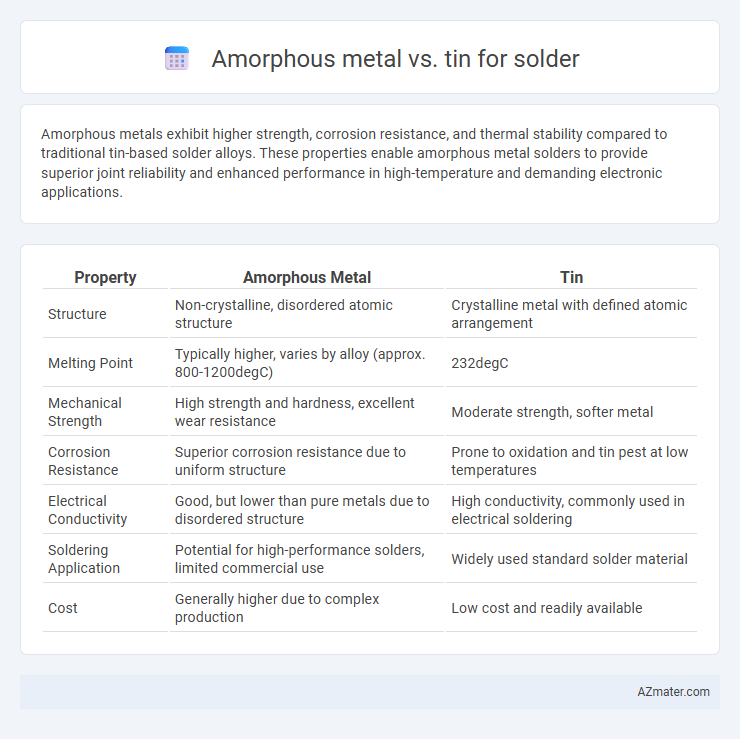Amorphous metals exhibit higher strength, corrosion resistance, and thermal stability compared to traditional tin-based solder alloys. These properties enable amorphous metal solders to provide superior joint reliability and enhanced performance in high-temperature and demanding electronic applications.
Table of Comparison
| Property | Amorphous Metal | Tin |
|---|---|---|
| Structure | Non-crystalline, disordered atomic structure | Crystalline metal with defined atomic arrangement |
| Melting Point | Typically higher, varies by alloy (approx. 800-1200degC) | 232degC |
| Mechanical Strength | High strength and hardness, excellent wear resistance | Moderate strength, softer metal |
| Corrosion Resistance | Superior corrosion resistance due to uniform structure | Prone to oxidation and tin pest at low temperatures |
| Electrical Conductivity | Good, but lower than pure metals due to disordered structure | High conductivity, commonly used in electrical soldering |
| Soldering Application | Potential for high-performance solders, limited commercial use | Widely used standard solder material |
| Cost | Generally higher due to complex production | Low cost and readily available |
Introduction to Solder Materials
Amorphous metals, also known as metallic glasses, offer superior corrosion resistance and mechanical strength compared to traditional tin-based solder materials used in electronic assemblies. Tin solder remains widely favored for its excellent electrical conductivity and ease of reflow during circuit board manufacturing processes. The choice between amorphous metal and tin solder hinges on application requirements, including thermal stability, electrical performance, and long-term reliability in harsh environments.
Overview of Amorphous Metals
Amorphous metals, also known as metallic glasses, exhibit a disordered atomic structure that provides superior mechanical strength, corrosion resistance, and thermal stability compared to traditional crystalline metals like tin. These unique properties enable amorphous metals to create more reliable and durable solder joints, reducing failure rates in electronic assemblies. Their higher melting points and improved fatigue resistance make amorphous metals an emerging alternative to tin-based solders in high-performance and high-reliability applications.
Key Properties of Tin Solder
Tin solder exhibits excellent electrical conductivity, ensuring reliable connections in electronic assemblies. Its low melting point, typically around 232degC, enables easy application without damaging sensitive components. Tin solder also offers good mechanical strength and corrosion resistance, making it a durable choice for various electronic soldering tasks.
Mechanical Strength Comparison
Amorphous metal solder exhibits superior mechanical strength compared to tin solder due to its non-crystalline atomic structure, which enhances its resistance to deformation and fatigue. The higher tensile strength and hardness of amorphous metals result in more reliable joints under cyclical mechanical stresses. In contrast, tin solder is prone to grain boundary weakening and creep, leading to lower durability in high-stress applications.
Electrical Conductivity Differences
Amorphous metals exhibit higher electrical conductivity than traditional tin solder due to their non-crystalline atomic structure, which reduces electron scattering. Tin solder typically has lower conductivity because of its crystalline grain boundaries that impede electron flow. The superior conductivity of amorphous metals enhances signal integrity and reduces resistive losses in electronic solder joints.
Corrosion Resistance Analysis
Amorphous metals exhibit superior corrosion resistance compared to tin due to their non-crystalline atomic structure, which eliminates grain boundaries and reduces pathways for corrosion. Tin solder, while widely used for its low melting point, is more susceptible to oxidation and whisker growth, leading to potential long-term reliability issues. Corrosion resistance in amorphous metal solder alloys results in enhanced durability and performance in harsh environments, making them preferable for critical electronic applications.
Melting Point and Processability
Amorphous metal solder exhibits a higher melting point compared to tin solder, typically melting above 900degC, whereas tin solder melts around 232degC, influencing thermal stability during electronic assembly. The increased melting point of amorphous metal enhances its resistance to thermal fatigue and creep, making it suitable for high-temperature applications. However, tin solder offers superior processability with lower melting temperatures that facilitate easier reflow processes and compatibility with sensitive components.
Environmental and Health Considerations
Amorphous metal solder offers significant environmental advantages over traditional tin solder due to its reduced need for hazardous metal mining and lower energy consumption during production. Unlike tin solder, which often contains lead and other toxic elements harmful to human health, amorphous metal alloys typically feature safer compositions that minimize toxic exposure during soldering processes. The recyclability and lower environmental impact of amorphous metals contribute to sustainable manufacturing practices and reduced occupational health risks in electronics assembly.
Cost and Commercial Availability
Amorphous metal solder typically incurs higher costs due to complex manufacturing processes and limited production scale compared to tin-based solders, which benefit from widespread availability and established supply chains. Tin solders dominate the commercial market with competitive pricing driven by mass production and global demand, making them highly accessible for various electronic and industrial applications. The cost efficiency and broad commercial availability of tin solder ensure its preference in most standard soldering tasks despite the superior mechanical properties of amorphous metal alternatives.
Application Suitability and Industry Trends
Amorphous metal solder offers superior mechanical strength, corrosion resistance, and thermal stability compared to traditional tin-based solder, making it ideal for high-performance electronics and aerospace applications. Tin solder remains prevalent in consumer electronics due to its lower cost, ease of use, and compliance with RoHS regulations despite limitations in durability under extreme conditions. Industry trends show increasing adoption of amorphous metal solder in advanced sectors prioritizing reliability and thermal fatigue resistance, while tin solder continues dominating mass production and cost-sensitive markets.

Infographic: Amorphous metal vs Tin for Solder
 azmater.com
azmater.com